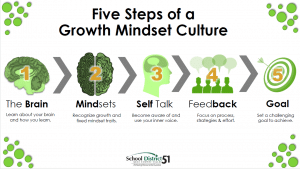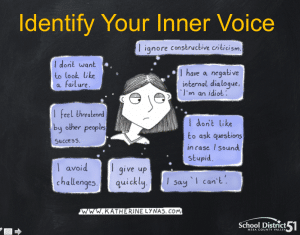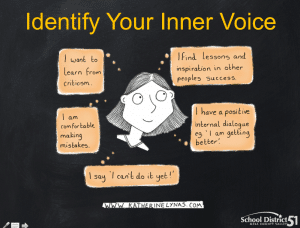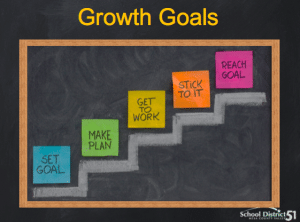Laying the Foundation with Culture and Climate
CompetencyWorks Blog
This article is the sixth in the Designing Performance-Based Learning at D51 series. A reminder: D51 uses the phrase performance-based learning or P-BL.

The first of District 51’s five phases of implementation is Laying the Foundation. The foundation they are speaking of is the culture and climate in which personalized, performance-based learning can take root. They describe this as “a culture where each student has ownership of his/her academic, social and emotional learning resulting in readiness for success in life.” This description helps you understand their vision for a personalized, performance-based system – the policies, procedures, school design, schedules, learning experiences, supports, and instructional cycle – that is going to help students build the skills they need to become lifelong learners.
D51 has focused most of their attention on creating a robust, empowered culture of learning with the growth mindset, social and emotional learning, and Habits of Mind at its very core. It’s important to remember that the features of their system and their process are also shaping the creation of the culture and climate. (See The Vision of Performance-Based Education at D51.)
There are three things that stood out for me about their efforts that are different than I’ve seen in other districts:
- Integration of the sixteen Habits of Mind into a Social & Emotional Learning Framework that is organized into developmental bands that will stretch from K-12.
- Focus on growth mindset that emphasizes helping students learn how to be aware of self-talk and how to create productive self-talk.
- Growth mindset is also influencing the efforts of designing the elements of the performance-based learning system and personalized support for teachers.
A Culture Rooted in the Growth Mindset
D51 talks about the growth mindset constantly – in professional learning sessions with teachers just becoming familiar with performance-based learning, in meetings with principals to build a culture of reflection as they stretch themselves to strengthen their understanding of their tasks as leaders, and in presentations in the community. It starts at the top – superintendent Steve Schultz models the growth mindset through reflecting on his own learning and a constant fail forward orientation.
Building the Culture and Climate to Support Growth Mindset
D51 has identified five strategies to help people, both students and adults alike, to learn to have a growth mindset. Posters are found all over the district highlighting the five steps: Brain, Mindsets, Self-Talk, Feedback, Goal. I’ve expanded on the third strategy, productive self-talk, as it is the first time I’ve heard a district focus this specifically on it. Click here for the Growth Mindset Learning Continuum.

1.Teach About the Brain: Students need to learn about the brain and how it works. Two important points that directly relate to the growth mindset: 1) their intelligence is not fixed and it can change, and 2) their intelligence can get stronger or weaker depending on effort that actually rewires the brain. I heard a facilitator in a professional development session call out with what sounded like true joy, “LET’S REWIRE!”
Resource Used by D51: Video on neuroplasticity, TED talk on The New Brain Science of Learning: Dr. Martha S. Burns, and Brainology Curriculum Guide for Parents.
2.Teach About Different Mindsets: Discussing the difference between a fixed mindset and a growth mindset is the standard approach for many schools that have introduced the growth mindset. D51 goes farther, seeking ways to operationalize it as described in the next three strategies.
Resource Used by D51: Video The Power of Yet and Keep Moving Foward (from Meet the Robinsons) are fun ways to start the conversation. This RSA video How To Help Every Child Fulfill Their Potential reviews Dweck’s Growth Mindset. This Harvard Business Review article and U.S. News and World Report article address misconceptions about the growth mindset.
3.Teach Productive Self-talk: What does it mean to practice a growth mindset? Persevere, put in more effort, try again.These are all the behaviors that we want to see, but what are the practices that lead to changing behavior when your impulse is to give up, take it easy, do something different? Certainly, we all know about the Power of Yet in the world of competency education: “I don’t like this…yet” leaves room for change. “I’m not good at this…yet” gives space for improvement. But that’s not enough to actually change behaviors.

D51 focuses on teachers helping students learn how to create productive self-talk. Rebecca Midles, Executive Director of Performance-Based Systems, pointed out, “Making sure students know how to have productive self-talk takes us to the very heart of equity. The quality of the self-talk depends on how they see themselves as learners. Students need to know how to identify their own self talk, to hear it, to acknowledge it, and to know how to be able to change it. This is one of the core tasks of students building agency.” This is the first time I’ve heard this point, so I’ll emphasize by repeating it – Students need to be able to identify, manage, and change their self-talk in order to fully develop ownership over their education.

D51 is building the supports to help teachers operationalize productive self-talk by linking it to the Social & Emotional Learning Framework (S&EL) described below. What are the types of productive self-talk you might use with the different Habits of Mind? Can you help students identify what is happening with them emotionally (Midles referred to this as the S&EL stance) so they become more self-aware and are able to tap into the metacognitive processes? A child slow to start on tasks might be focused on perfection or is perhaps too afraid to ask for more direction to avoid looking silly. Children will need a new pattern of self-talk to help them change their behavior (in this case, to take risks), change the perception of their goal or surroundings, or identify what they need to feel safe enough to do so.
Resource Used by D51: A Mindset for Learning: Teaching the Traits of Joyful, Independent Growth by Mraz and Hertz.
4. Use Growth Mindset Feedback: The D51 training on growth mindset includes praise and feedback. Praise, the incredible power of reinforcing desired behaviors, should focus on the the process, not the child. For example:
- Great choice in taking on such a hard task.
- I noticed you are thinking through the steps.
- I am watching the way you’re approaching this and I think your effort is outstanding.
In a professional development session, the facilitator explained, “If you praise a student for getting done first, then you are emphasizing speed or being smart. Without meaning to, we undermine ourselves. The counterpoint is that the task was too easy for the student. So when a student hands something in very quickly, we can say, “I’m sorry that the work wasn’t that challenging. Let’s try something else.”
Praise is important, but equally so is the feedback when students haven’t met their goals. Feedback might include:
- You are not there/here yet.
- This may be tough, but you can do it.
- Let’s break it down into steps.
- I expect that you are going to make mistakes. It is the kind of mistakes you make along the way that let me know how to support you.
The power of critique, feedback, and revision will be important for students developing a growth mindset. It’s one thing to say, “I’m going to draw a butterfly,” but an entirely different thing to draw a well-defined, proportionate, true-to-life butterfly that demonstrates elements of anatomy. Personally, I was blown away by the level of growth demonstrated in the video below when a child receives a detailed critique and opportunity for revision. It helped me come to terms that we are absolutely underestimating what children can do.
Resource Used by D51: The Story of Austin’s Butterfly and Study on Praise and Mindset.
5. Set Challenging Goals To Change Habits: Students need to know how to set goals in order to change habits. Midles emphasizes that it is important to set goals that are hard – otherwise, you won’t really be able to learn the growth mindset. The facilitator in the professional development session explained, “Do not set a growth goal for something you will eventually get. You have to set it around something you don’t think you can do and then think about what strategies you can apply to reach this fixed goal (a goal that you can’t do). Once students get through this process, they will be on fire. The sky is the limit.”

Students can’t just stop at setting a growth goal; they learn how to make a plan, reflect on their progress, and build in the supports they need to succeed. Goals aren’t just about academics – they might include managing emotions, behaviors, habits, physical health, or relationships.
Social & Emotional Learning
With the growth mindset as a foundation, D51 wanted to deepen it to address the social-emotional aspects of learning. Yet, Habits of Mind (HoM) had been introduced several years ago (although they weren’t used systematically throughout the district) without much result. The difficulty is that there are sixteen of the habits – all important, of course, but difficult to operationalize and certainly too numerous to integrate into the core culture. In addition, HoM don’t touch on social and emotional learning as explicitly as we are finding we need if we are going to reach and engage every student. So how might we integrate S&EL and HoM?

D51 is starting with a model used by the Anchorage School District with bands for K-2, 3-5, middle school, and high school to guide conversation. Social & Emotional Learning standards are organized into four quadrants: Self-Awareness (I Am), Self-Management (I Can), Social Awareness (I Care), and Social Management (I Will). Examples of indicators of S&EL standards are included in each quadrant.

The next step is to crosswalk these standards to the Habits of Mind. For example, under the category Self-Awareness, early elementary has S&EL standards such as I am aware of what I am feeling with an indicators such as Can describe their emotions and the situations that cause them. When you get to high school, that very same standard is related to metacognition, one of the Habits of Mind with indicators such as Can describe how changing their interpretation of an event can alter how they feel about it.
At this point, D51 is not going to create rubrics for the S&EL standards. “Schools tend to be quick to grab onto tools and put them into use immediately,” explained Midles. “However, if you want to help students develop a growth mindset, build their social-emotional learning, and develop the Habits of Mind needed to succeed, it will be important to make sure your teachers know how to coach, assess, and provide productive feedback. This is likely to be a new set of instructional strategies for some teachers, and districts need to design supports for teachers before students begin to be assessed.”
“Most of all,” she continued, “it is very important to avoid anything that looks or feels like grades when helping students build this set of learning-to-learn skills. We can reinforce the fixed mindset if we assess students on S&EL and HoM too soon. We can create a stigma without meaning to because we are providing feedback that can be interpreted as personality rather than skill. Children are trying to figure out who they are as a person and can be quick to interpret feedback as something permanent. Social-emotional learning is about them building the skills they need to become lifelong learners. This is about building the skills they need to tap into their intrinsic motivation for learning.”
Integrating the Growth Mindset and S&EL into District Operations
D51 is as interested in helping students and adults in the district develop a growth mindset as it is in creating a growth mindset culture. They are thinking about specific practices individuals need to become adept at, the way to design and tools to be growth-generating, and the way meetings and professional development are designed to observe and capture learning. In other words, D51 is working to make the growth mindset pervasive in everything it does. Here are a few examples:
- The professional learning facilitators are creating a continuum for each Design Lab. The expectation is that they will guide self-assessment and set growth targets, but not be used for evaluation.
- D51 is trying to build on other efforts to further operationalize S&EL. For example, the Colorado Department of Education (with the Colorado Education Initiative and Panorama) piloted a student perception survey. D51 took advantage of the pilot to get the pulse of the climate in their school. Eighty percent of the 21,000 students took the survey, and D51 is awaiting the results. The hope is that this survey can be woven into the S&EL Framework so it can provide feedback on at least some of the standards.
The D51 team thinks about the growth mindset in everything they do. In considering using ACT Work Ready tools there was conversation about the impact of their use of averaging and to what degree it impedes students staying focused on growth. Paul Jebe, Director of Educational Effectiveness, emphasized, “Rubrics need to be designed to be growth-producing, whether they are used in the classroom or for teacher evaluation.” Assessment and feedback are seen as an important part of the learning cycle throughout D51 for students and teachers alike. For example, the teachers who are now on special assignment coaching other teachers are entering the field of adult education. Each have worked with Jebe to create a personalized evaluation tool to guide them.
In a conversation with Deb Bailey, middle school leadership support, we talked about other aspects of their work on S&EL. D51 is seeking to have zero expulsion (as compared to zero tolerance policies that were the spark that ignited school-to-prison policies) by using restorative policies and family and student advocates. Bailey explained that the hope is to integrate S&EL and restorative practices so that they are tightly woven into the culture. She also approaches the multi-tiered system of supports broadly, in that it applies wholistically to students rather than solely on academics. She sees the culture of performance-based learning helpful in supporting students with behavioral issues, as it more natural to talk about responsibility and self-management that way. Counselors and behavior therapists are also available to help students so they can remain in their learning communities.
One of the results of such a strong culture designed around safety, social-emotional learning, and growth mindset is that discipline issues decline. Certainly, we have seen that in Lindsay Unified. Bailey pointed out, “When you have a strong foundation of S&EL and growth mindset, schools can repurpose the role of assistant principal to be about making more connections rather than discipline.”
A final note: Many schools in D51 aren’t waiting to be accepted as demonstration schools. They are already learning about the growth mindset and social-emotional learning so that they are ready for the next step as soon as the district is ready. What this means is that there may be an accelerated pace to implementation. For districts just starting to explore the option of competency-based education, the takeaway is clear: Start laying the groundwork now.
Read the Entire Series:
Post #1 – Designing Performance-Based Learning at D51
Post #2 – Building Consensus for Change at D51
Post #3 – The Vision of Performance-Based Education at D51
Post #4 – Holacracy: Organizing for Change at D51
Post #5 – Growing into the Framework: D51’s Implementation Strategy